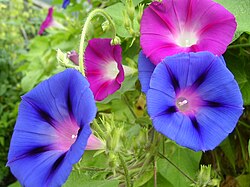Ipomoea purpurea
| Ipomoea purpurea subsp. var. | Purple, Tall, or Common Morning Glory | |||||||||||||||||||||||||||||||||||||||||||||||||||||||
|---|---|---|---|---|---|---|---|---|---|---|---|---|---|---|---|---|---|---|---|---|---|---|---|---|---|---|---|---|---|---|---|---|---|---|---|---|---|---|---|---|---|---|---|---|---|---|---|---|---|---|---|---|---|---|---|---|

|
|
| ||||||||||||||||||||||||||||||||||||||||||||||||||||||
| ||||||||||||||||||||||||||||||||||||||||||||||||||||||||
Ipomoea purpurea, the Purple, Tall, or Common Morning Glory, is a species in the genus Ipomoea, native to Mexico and Central America. Like all morning glories the plant entwines itself around structures, growing to a height of 2-3 m tall. The leaves are heart-shaped and the stems are covered with brown hairs. The flowers are trumpet-shaped, predominantly blue to purple or white, 3-6 cm diameter. [1]
The plant is predisposed to moist and rich soil, but can be found growing in a wide array of soil types.[2] It is naturalized throughout warm temperate and subtropical regions of the world. Although it is often considered a noxious weed, Ipomoea purpurea is also grown for its beautiful purple and white flowers and has many cultivars. Common cultivars include I. purpurea 'Crimson Rambler' (red-violet blossoms with white throats); 'Grandpa Ott's,' 'Kniola's Black Knight,' and 'Star of Yelta' (blossoms in varying shades of deep purple with white or pale pink throats); and 'Milky Way' (white blossoms with mauve accents).
| Standard Cyclopedia of Horticulture |
|---|
|
Ipomoea purpurea, Roth (Convolvulus majus, Hort. Convolvulus purpureus, Linn.). Tall Morning-glory. St. trailing or twining for 4-10 ft., branching from the base: peduncles slender, 1-5-fld., often longer than the petioles: corolla 1-2 in. long, light blue, purple, pink and diversely variegated. July-Sept. Trop. Amer. Escaped from gardens to waste places, Canada to Fla., west to Neb. and Texas, widely distributed in most tropical regions. —One of the most popular of garden annuals. Some of its varieties resemble the entire- leaved forms of I. hederacea, but may be distinguished by their longer and more slender peduncles, umbellate pedicels, and oblong-acute sepals without the long tip usually found on I. hederacea. Seeds ripen freely on cult, varieties and may be gathered for future sowings. Among the host of garden forms are: alba, white; atro-caerulea, dark blue; atro- sanguinea, dark purple; azurea, sky-blue; carminata, light crimson ; dickensonii (Pharbitis hispida var. dickensonii), azure- blue; huberi (I. huberi var. variegata, Hort.). Lvs. marked with silvery white, fls. variously colored and margined with white; kermesina (I. kermesina), scarlet; rosea., blush-rose; varia, a trade name for packages containing a mixture of many kinds; violacea-striata, violet-purple. There are several double forms of I. purpurea. var. flore-pleno, has very large lvs.: fls. appearing much later than single varieties, semi- or much-doubled, bluish white streaked with light blue or pink. Intro. 1892. Said to be very floriferous and a good pot-plant.
|
Cultivation
Propagation
Pests and diseases
Varieties
Gallery
-
Light blue I. purpurea
-
Pink Ipomoea purpurea
-
Pink Ipomoea purpurea close-up
-
Ipomoea purpurea in Loganville, Georgia
-
Pink Ipomoea purpurea
References
- ↑ Germplasm Resources Information Network: Ipomoea purpurea
- ↑ Richard H. Uva, Joseph C. Neal and Joseph M. Ditomaso, Weeds of The Northeast, (Ithaca, NY: Cornell University Press, 1997), Pp. 214-217
- Standard Cyclopedia of Horticulture, by L. H. Bailey, MacMillan Co., 1963
External links
- w:Ipomoea purpurea. Some of the material on this page may be from Wikipedia, under the Creative Commons license.
- Ipomoea purpurea QR Code (Size 50, 100, 200, 500)





